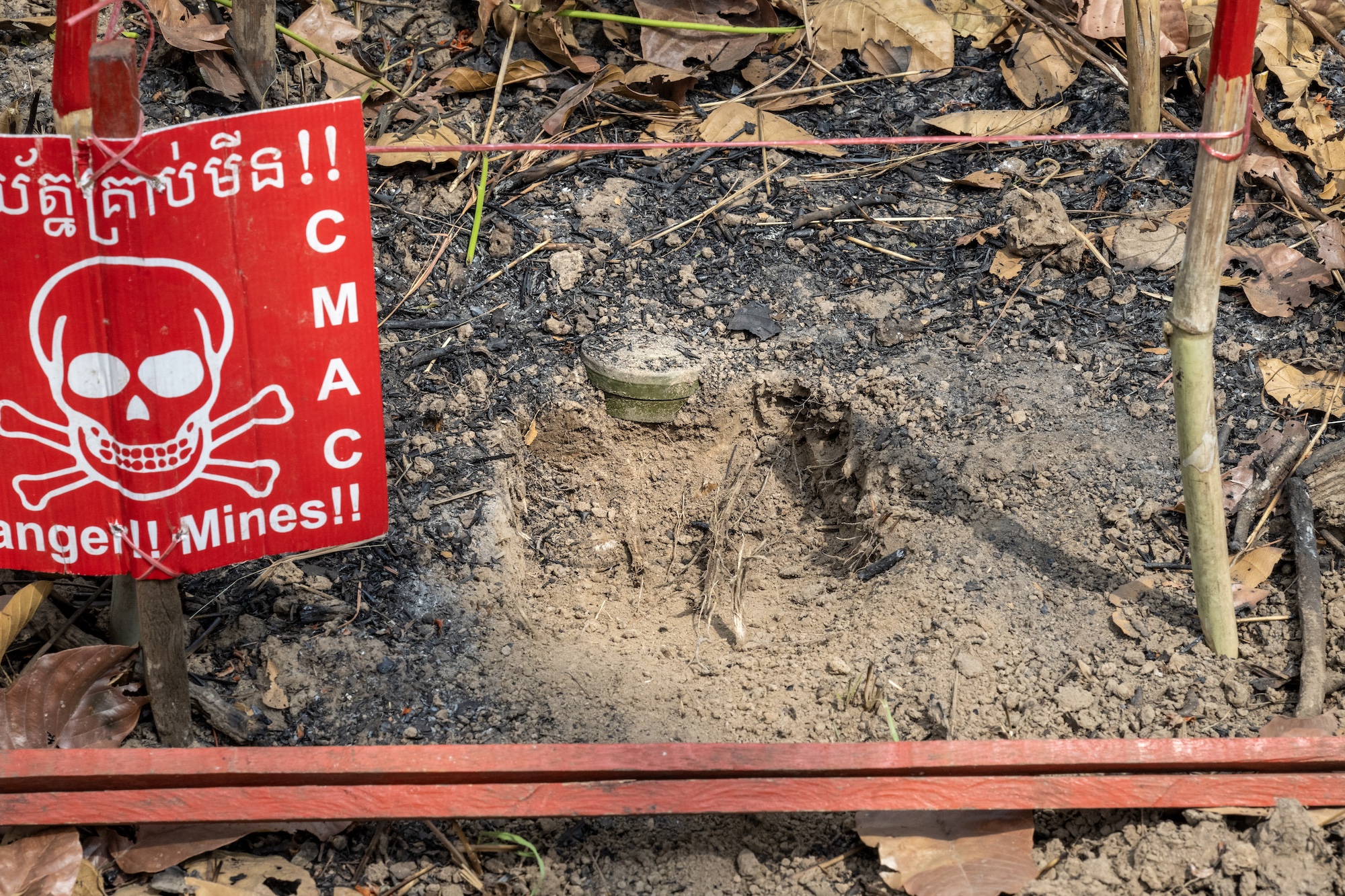On International Day for Mine Awareness and Assistance in Mine Action APOPO is sharing some not-so-fun facts about an issue that’s anything but lighthearted – landmines. It’s a seriously sobering list but our final three facts also highlight how APOPO, our HeroRATs, HeroDOGs, and our brave human deminers are working to eradicate the problem one landmine at a time.
- Landmines never expire: Unlike the perishables in your fridge, landmines don’t come with a limited shelf life. Some of these explosive remnants of war have been lying in wait for over half a century, still as deadly as the day they were planted. They are the gift that keeps on giving, but one that nobody wants to receive.
- There are enough landmines under the ground to circle the earth…twice: Imagine a belt made of explosives encircling the globe not once but twice. Estimated at over 110 million active landmines are still buried in over 60 countries worldwide, the scale of the problem is not just global; it’s astronomical.
- Landmines are cheap to make but costly to remove: Producing a landmine can cost as little as $3, but removing it safely? That can set mine action organizations back up to $1,000 per mine. Clearing all existing landmines is projected to cost between $50 to $100 billion due to the enormous logistical effort required to make lands safe again… and somewhere in the world landmines are still being planted and causing both military and civilian casualties every day.
- Landmines are small in size, but massive in impact: Most landmines are no bigger than a hockey puck, but their effects are anything but small. Each uncleared landmine has the instant potential to change lives, landscapes, and futures for the worse.
- Landmines are not only designed to kill: Often designed to maim rather than kill, landmines have an impact far beyond the battlefield, indiscriminately targeting military resources, civilians, peacekeepers, and aid workers. This approach, aimed at overwhelming an enemy forces’ support systems during conflict, continues to inflict harm in peacetime, particularly in places like Cambodia which reports the highest rate of amputees worldwide.
- Landmines kill or injure almost 5,000 people per year: According to the Landmine Monitor in 2022, at least 4,710 casualties of mines and explosive remnants of war (ERW) were recorded (1,661 killed and 3,015 injured). The aftermath of each landmine casualty affects whole families and entire communities, with each incident transforming lives and forcing adjustments to new, harsh realities. The devastating truth is that hundreds of thousands of individuals are forced into a daily battle against grief, disability, and economic hardship.
- Landmines stunt growth without ever going off: Landmines silently stall economic growth, transforming arable land that is full of potential into no-go zones without ever detonating. This invisible threat taxes communities with unrealized potential and lost opportunities, denying regions the prosperity they deserve. In landmine economics, the true cost is measured in stifled growth and progress.
- Landmines turn every step into a gamble: In regions littered with these devices, ordinary activities like heading home, kicking a ball, or working the land carry the risk of setting off an explosion. Every patch of ground holds the potential for catastrophe, turning what should be simple movements into high-stakes decisions. Imagine living with the constant awareness that the ground beneath you could, at any moment, upend life as you know it.
- Landmines meet their match in rats: APOPO’s HeroRATs are the unexpected heroes on the frontline of demining. With their keen sense of smell, our whiskered warriors are adept at detecting explosives without ever setting them off. This allows their human teammates to neutralize the landmines and return the land to local communities. It’s a surprising twist in the tale – rats, often considered pests, are pivotal in detecting danger and helping to destroy it.
- Landmines are outsmarted by APOPO’s HeroDOGs: Our trained technical survey dogs (TSD) excel at sniffing out danger, making them invaluable in efforts to reclaim and secure land. It’s a stark reminder that man’s best friend can be a lifesaver. Four active legs and a keen nose can be the difference between life as usual and a devastating explosion.
- Mine action clears the way forward: Humanitarian mine action organizations like APOPO aren’t just removing landmines; we’re helping to save and rebuild lives. Each cleared landmine means safer communities, healthier land, and hope for the millions of people affected by these hidden hazards.
This list of facts covers the sobering impact of all categories of landmines on individuals and communities across the globe. Now let’s turn our attention to the landmines themselves, what they are, how they work, and the types of landmines laid in conflicts. This should provide a clearer understanding of the challenges involved in addressing and ultimately overcoming this continued threat.
What are Landmines?

Landmines are a type of munition designed to explode when triggered by pressure, proximity, or a time mechanism. Their primary use has been in military operations to create defensive barriers, disrupt or channel enemy movements, and protect strategic areas. However, these indiscriminate weapons remain a persistent and lethal threat to civilians long after conflicts have ended.
History of Landmines
Most modern types of anti-personnel landmines have been in use since World War II. However, similar devices have been used in armed conflict since at least the 1800s and arguably several centuries earlier.
In more recent times the targeted effectiveness of landmines has been ‘improved’ with the use of advanced technologies. New, so-called ‘smart mines’ are designed to deactivate after a limited period of time, supposedly with the intention of reducing their post-conflict impact. However, smart mines are often laid at a rate of thousand per minute, making them as dangerous, if not more than traditional landmines.
Let’s explore the basic working principles of landmines:
Types of Landmines
There are two main categories of landmines: anti-personnel landmines (AP) and anti-tank (AT) landmines.
- Anti-Personnel Mines: Smaller than AT mines, they are designed to kill or injure individuals. They can be triggered by much less pressure, sometimes as little as 5 to 15 kilograms (11 to 33 pounds), making them a direct threat to civilians.
- Anti-Tank Mines: Designed to damage or destroy vehicles, including tanks and armored vehicles. Anti-tank mines require significant pressure to detonate, typically over 100 kilograms (about 220 pounds), which means they are not generally triggered by human footsteps.
Landmine Trigger Mechanisms
Landmines are explosive devices that can be activated through several mechanisms:
- Pressure-Activated: The most common type, these mines detonate when pressure is applied to them, such as when stepped on or driven over. They use a mechanical or electronic pressure plate.
- Tripwire: Some antipersonnel mines are triggered by a wire or filament stretched across a path. When disturbed, the wire activates the mine.
- Command-Detonated: These mines are set off manually by an operator through an electrical or mechanical signal.
- Timed: Incorporating a timer to detonate at a specific moment, though less common due to their predictable nature and limited tactical utility.
- Remotely Operated: Advanced mines can be detonated remotely using a wireless signal, allowing for strategic use in combat situations.
Internal Mechanics of Landmines
The internal mechanism of a landmine typically consists of the following components:
- Explosive Booster Charge: The main component that detonates, causing the mine’s destructive effects.
- Detonator or Firing Pin: Initiates the explosion. For pressure-activated mines, stepping on the mine drives a firing pin into a detonator cap, which ignites the main charge.
- Triggering Mechanism: This varies based on the type of mine and can include pressure plates, tripwires, or electronic sensors.
- Casing: Houses the explosive components. It is most commonly made of metal but can be made from plastic, or other materials, which affects detection efforts (plastic mines are harder to detect using traditional metal detectors).
The Life-altering and Lethal Effects of Landmines
Blast Landmines: The most common type of AP mine, creating a powerful explosion intended to cause injury or death to people nearby.
Fragmentation Mines: Designed to project sharp fragments or shrapnel at high speeds over a wide area. Directed fragmentation landmines propel shrapnel toward the people that have activated them.
Bounding Mines: These mines launch into the air before exploding, maximizing injury over a larger radius. This type of fragmentation landmine shoots up into the air and explodes around 1 meter above the ground. This is around waist level for most adults and head level for small children.
Landmines remain active until they are detonated or defused, posing a risk for decades. This enduring hazard is the driving force behind APOPO’s demining efforts and the development of technologies and strategies to safely remove and neutralize landmines, helping to restore safe access to land and communities affected by conflict.
Find out more about how APOPO clears landmines.
You can adopt a landmine detection rat and contribute towards a Mine Free World.
APOPO is deeply grateful for the support and generosity of our partners and donors over the years that makes our work possible.



